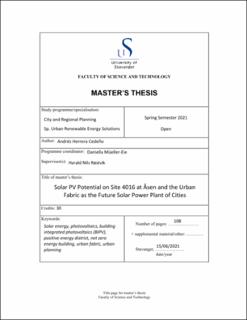| dc.description.abstract | With the urgent necessity for humans to take radical action to stop the impending climate crisis, it is necessary to cut carbon emissions as soon as possible to prevent further damage. Cities are one of the main sources of human-made emissions and considering the expected rise in urbanization in the upcoming years, sustainable urban development practices must be adopted to reshape cities around the world and be able to achieve the climate goals. The incorporation of positive energy districts (PEDs) and net-zero energy buildings (NZEB) into the urban centers by integrating renewable energy sources into the urban fabric to cover the energy needs of the city itself is a possible solution to the problem.
In this thesis, the solar potential of Site 4016—an existing area in Åsen, Stavanger, Norway that is planned to be further developed and densified in the next years into a modern regional knowledge and development center for the construction sector—will be analyzed to explore the possibility of transforming the site into a PED through the integration of photovoltaics (PVs) to generate electricity. The annual solar irradiance received by the surfaces of the buildings for both the existing development and the future 2030 development was analyzed using the DL-Light tool for Sketchup. The potential to generate power was calculated based on future PV efficiency estimations and balanced out with the energy consumption estimations to obtain a total energy balance. For the future development of the site two energy consumption scenarios were analyzed: a scenario where 30% energy efficiency has been met that resulted in the site having the potential to generate enough power to cover up to 70% of the annual energy consumed, and an ultra-high energy efficiency scenario where the site could potentially become a PED being able to cover 115% of the annual energy need and generating 1 390 000 kWh of excess energy annually. The characteristics of the urban fabric that could help increase the solar potential of an urban area were discussed as well as some efficiency practices that could lead to the low energy consumption that is needed to achieve a PED. | |
